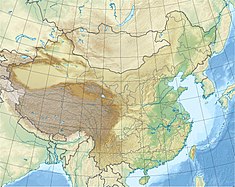Jilebulake Dam
| Jilebulake Dam | |
|---|---|
| Country | China |
| Location | Habahe County |
| Coordinates | 48°15′51.96″N 86°23′55.72″E / 48.2644333°N 86.3988111°E |
| Purpose | Power |
| Status | Operational |
| Construction began | 2009 |
| Opening date | 2013 |
| Dam and spillways | |
| Type of dam | Embankment, concrete-face rock-fill |
| Impounds | Haba River |
| Height | 146.30 m (480.0 ft) |
| Length | 464 m (1,522 ft) |
| Width (crest) | 10 m (33 ft) |
| Reservoir | |
| Total capacity | 232,000,000 m3 (188,000 acre⋅ft) |
| Surface area | 5.15 km2 (1.99 sq mi) |
| Commission date | 2014 |
| Turbines | 2 x 50 MW, 2 x 30 MW Francis-type |
| Installed capacity | 160 MW |
The Jilebulake Dam (Chinese: 吉勒布拉克水坝) is a concrete-face rock-fill dam on the Haba River, a tributary of the Irtysh, in Habahe County of the Xinjiang Uyghur Autonomous Region in China. The primary purpose of the dam is hydroelectric power generation and it supports a 160 MW power station. Construction on the 146.30 m (480.0 ft) tall dam began in 2009 and its reservoir began to fill in November 2013.[1][2][3] During filling, on November 17, the diversion tunnel gate failed and the water inside the reservoir rushed downstream. Locals downstream were evacuated and there was no loss of life.[4] The Shankou Dam just downstream was able to control much of the flooding.[5]
See also[edit]
- List of dams and reservoirs in China
- List of tallest dams in the world
- List of tallest dams in China
References[edit]
- ^ "Xinjiang Gilles Braque Station will return to work next month" (in Chinese). China Energy News. 22 March 2012. Archived from the original on 5 June 2012. Retrieved 6 March 2014.
- ^ "Hydropower failure occurred in Xinjiang more than a thousand people were evacuated flood" (in Chinese). Sound of Hope. 18 November 2013. Retrieved 6 March 2014.
- ^ "Xinjiang Haba River Jilebulake Hydro Power Project". UN CDM. 20 December 2012. Retrieved 6 March 2014.[permanent dead link]
- ^ "Habahe hydropower gate runaway stuffed danger: no casualties" (in Chinese). Nandu. 18 November 2013. Archived from the original on 7 March 2014. Retrieved 6 March 2014.
- ^ "Closely monitoring the flood water Habahe Yamaguchi" (in Chinese). Technology Co., Ltd. Beijing Ying Tat. Archived from the original on 7 March 2014. Retrieved 7 March 2014.

